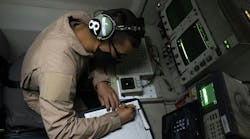Coast Guard contract starts second big Maritime Security Cutter
The U.S. Coast Guard awarded a $144 million contract to Integrated Coast Guard Systems (ICGS) LLC to build the Coast Guard’s second Maritime Security Cutter Large (WMSL), which is the largest of three new cutter classes, and the first under construction within the Coast Guard’s Integrated Deepwater System (IDS) acquisition program. The WMSL is 421 feet long, draws 21 feet of water, and steams as fast as 29 knots. It has a stern launch ramp, 57 mm and 0.50 caliber guns, and hangar for a multimission helicopter and unmanned air vehicles. Construction on the first WMSL began in September 2004, with the ship delivery scheduled in 2007. The anticipated delivery schedule for the second WMSL is late 2008. The Deepwater System’s Integrator, ICGS, is an equal partnership between Lockheed Martin and Northrop Grumman Ship Systems. ICGS will subsequently issue subcontracts for Northrop Grumman Ship Systems to lead the WMSL production efforts in Pascagoula, Miss., while Lockheed will assume primary responsibility for integrating the ship into the system-wide command, control, communications, computers, intelligence, surveillance, and reconnaissance (C4ISR) architecture.
RFID-tag market to approach $3 billion in 2009
Radio-frequency-identification (RFID) tags are poised to become the most far-reaching wireless technology since the cell phone, according to high-tech market research firm In-Stat in Scottsdale, Ariz. Worldwide revenues from RFID tags will jump from $300 million in 2004 to $2.8 billion in 2009, In-Stat analysts predict. During this period, the technology will appear in many industries with significant influence on the efficiency of business processes. The report, RFID Tags And Chips: Changing The World For Less Than The Price Of A Cup Of Coffee, contains estimates and a five-year forecast for the number of tags, revenue from tags, and semiconductor revenue from tags, broken down into 10 segments: livestock, domestic pets, humans, cartons/supply chain uses, pharmaceuticals, large freight containers, package tracking, consumer products, security/banking/purchasing/access control, and other. To purchase this report, or for more information, contact In-Stat’s Tina Sheltra by phone at 480-609-4531, by e-mail at [email protected] or online at www.instat.com/catalog/scatalogue.asp?ID=3.
Motorola offering to improve fingerprint identification
Officials at Motorola Inc. in Schaumburg, Ill., launched their Printrak LiveScan product lines to assist public safety agencies by providing improved processes to identity fingerprint and palmprint images. In its 4th generation, the new system incorporates suggestions from Motorola’s LiveScan 3000 worldwide customer base, which is composed of law enforcement agencies that use automated fingerprint identification systems. Features on the LiveScan product lines include FBI Appendix F certified software and portable scanner, sequence checking for both fingerprints and palmprints, three-part full-palm capture (upper/lower/writer’s), specifically designed for touch-screen operation with industrial commercial-off-the-shelf (COTS) display, capture maximum image size allowable by National Institute of Standards and Technology (NIST) and the FBI, no moving platen or capture camera, instant live video of the fingerprint and palmprint images feedback, XML- (Extensible Mark-Up language) or NIST-based foreign system interface, and multilanguage support with translation table. Systems are being delivered to public safety agencies and forensics agencies in Minnesota, South Dakota, New Mexico, and Belgium. For more information go to www.motorola.com
Xybernaut Corp. forms homeland security division
Officials at Xybernaut Corp. in Fairfax, Va., say they formed a Homeland Security division because of strong demand from government and private-sector customers for the company’s homeland security and emergency preparedness systems and services. All branches of the U.S. armed forces use Xybernaut systems, and some have been deployed into emergency preparedness, critical incident response, and site security homeland security applications. The company has also formed a Homeland Security Advisory Board with retired U.S. Army Gens. William G.T. Tuttle and Harry E. Soyster. Xybernaut spearheaded an effort to create a Critical Incident Response Tool Kit for emergency technicians and other “first responder” teams in the Charleston, S.C. metropolitan area. This initiative was funded by and coordinated with the U.S. Department of Justice’s National Institute of Justice (NIJ), to develop best practices and technologies focusing on facility security, emergency preparedness, and disaster response. For more information go online at www.xybernaut.com.


